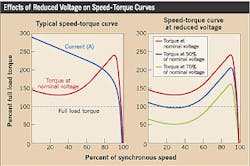Undervoltage is defined as a condition where the applied voltage drops to 90% of rated voltage, or less, for at least 1 minute. Low-voltage conditions occur when a facility asks for more power than the line can deliver. But take note that it's not always an issue of the electric utility not having adequate capacity — transformers can act like a choke, restricting how much total power gets through to your system. Perhaps the facility (or a neighbor on the same electric utility transmission line) added new equipment and increased the load beyond what the line could deliver. In isolated cases, maybe the facility added a motor with a long cable run, and the voltage drop in that circuit resulted in low voltage at that motor. Brief low-voltage conditions can also happen when someone starts a large load without notifying the power company, or when the power is shorted to ground or to another line. Even loose cable connections can cause low voltage.
To illustrate why low-voltage levels are unhealthy for electric motors, let's review the relationship between motor torque and applied voltage (Fig. 1).
Low-voltage lowdown. For an electric motor, torque changes as the square of the voltage applied. A 10% increase in voltage, for example, will boost torque 21% (1.1×1.1=1.21). Conversely, at 90% of rated voltage, the motor suffers a 19% reduction in torque (0.9×0.9=0.81). A more severe undervoltage condition, 20% below rated value, would reduce the motors torque to only 64% of rating (0.8×0.8 =.64). The effects are a 156% overload and catastrophic failure.
If torque decreases below the torque required by the load, the motor would stall. At that point, the only product of the motor is heat. However, a 100-hp motor, with locked rotor, becomes a 500kW resistive heater.
Excess heat is a problem for motors because insulation life is halved for every 10°C increase in temperature (Fig. 2). At the same time, the temperature of the winding will rise 10°C to 15°C for each 10% drop in voltage. That means the insulation life of a motor that operates on 10% lower voltage will decrease to only 50% to 75% of its expected life.
Undervoltage events that last long enough to increase winding temperature cause irrevocable damage to winding insulation and unexpected failures later. A sustained low-voltage event can damage the insulation system of every electric motor running during the event. The only motor that's safe during a prolonged undervoltage event is one that's turned off.
Beat the heat. The undervoltage condition that accompanies brownouts and power outages has expensive repercussions, like increased motor failures and lost production. However, quick response techniques and computer-controlled equipment can reduce or even eliminate the effects of such low-voltage events.
Basic safeguards include monitoring the supply voltage and training personnel to respond quickly if it drops to a predetermined level. For critical applications, install thermal protectors or condition-monitoring devices that can detect abnormally high winding temperatures and shut down the motor. If shutting down isn't an option, reduce the load by throttling back a fan or partially closing a valve during a brownout. Fig. 3 shows the effect of reduced voltage levels on motor windings.
If you don't take proactive steps, you could be setting yourself up for serious problems. The magnetic contactor used to turn motors on and off includes a holding coil, which is basically a solenoid that, when energized, pulls in the contactor to complete the circuit to the motor. Low-voltage conditions, however brief, also affect the holding coil, causing a contactor to drop out, or the motor to unexpectedly de-energize or begin to chatter — meaning the contacts “make and break” repeatedly during the undervoltage event. Turning a motor on and off that quickly can damage the windings. The effect is a bit like starting a motor at 1½ times rated voltage, so relying on a holding coil to interrupt the motor isn't the best option.
Better options include a PLC, Multi-LIN, or similar device. Marketed under several trade names, several of these devices are controllers that can literally be programmed to respond the way you want them to. In the old days, an operator made a best-guess reaction to what he thought was happening. Right or wrong, once someone turns off the lights you're stuck with the consequences of cleaning up the process line and restarting your systems.
Thanks to computers, just about everything can be controlled more accurately now, including electric motors. Devices smaller than a breadbox hold the guts to start the motor, monitor the power quality, and respond the way an experienced operator would — every time. Instead of guessing whether the voltage is low, or unbalanced, the controller knows and handles the situation for you.
If your power quality survey found that most of your undervoltage events are shorter than 30 seconds, you can program the controller to ignore events less than 40 seconds in length, or any other number you like. If NEMA MG1 says a 2% voltage unbalance means the motor should be downrated to 90% of rated horsepower, you can program the controller to do so when it detects a 2% voltage unbalance.
Electric motors are used to produce nearly everything you can think of, so you should be proactive in protecting them against low-voltage events. If you find that low-voltage events are caused by outside forces (a neighboring plant, for example), remember the old adage “Good fences make good neighbors.” Talk to your electric utility representative about updating their substation to better serve you.
Yung is a technical support specialist at the Electrical Apparatus Service Association (EASA) in St. Louis.
